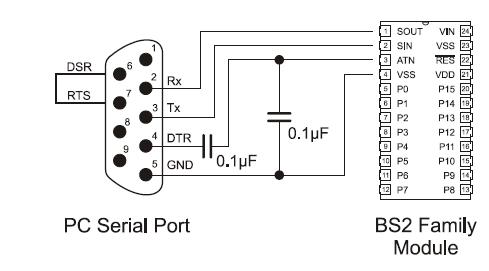No BASIC Stamps found.
I have just begun trying to operate my basic stamp without a carrier board. I have the stamp in a breadboard with the proper power voltage across pins 23 and 24. My problem is with the serial connection. I am using the attached diagram to wire my serial cable to the breadboard. When I identify stamps or attempt to load a program, I get the error message "No BASIC Stamps found." COM1 sees an echo, but no loopback, and no stamp. I am not using COM2. Any ideas?



Comments
The "no loopback" is a problem, because "Loopback" is supposed to be detecting that wire between the DB-9 pin 6 and 7. That your port isn't detecting that wire indicates some problem with your serial port. I mean, you can't get more simple than a dumb piece of wire.
Are you perhaps using a "Null-Modem" cable? Are you using a USB to serial adapter?
I am not using a USB to serial adapter. I am not using a null modem cable. I will investigate my connection between pins 6 and 7. Are you absolutely sure that a bad connection between pins 6 and 7 will result in the "no loopback" problem?
And yes, I'm absolutely sure the "loopback" test is testing the presence (or absence) of that little piece of wire between pins 6 and 7. That's kind of a "raw hardware" test, that indicates you ARE using the right serial port, and that it IS physically connected to a BOE or Homework Board or at least connected to SOMETHING with pin 6 and 7 shorted together.
Oh, and 13.6 volts DC (it IS DC, right?) should be just fine across Vin and Vss.·
▔▔▔▔▔▔▔▔▔▔▔▔▔▔▔▔▔▔▔▔▔▔▔▔
- Stephen
▔▔▔▔▔▔▔▔▔▔▔▔▔▔▔▔▔▔▔▔▔▔▔▔
· -- Carl, nn5i@arrl.net
The Stamp SIN/SOUT/ATN inputs are designed for direct connection to an RS232 port. Look at the schematics in the Stamp Manual for details. The ATN needs the capacitors shown because most PCs hold the DTR line active the whole time the serial port is open and that will hold the Stamp in reset without the capacitors. With the capacitors, the Stamp resets on the leading and trailing edges only of the DTR signal.
▔▔▔▔▔▔▔▔▔▔▔▔▔▔▔▔▔▔▔▔▔▔▔▔
· -- Carl, nn5i@arrl.net
Post Edited (Carl Hayes) : 12/9/2008 2:40:19 AM GMT
But if you don't use Hyperterm, you don't need the two capacitors.
And yes, Mike is entirely correct, the SIN and SOUT pins do have 'level shifting' transistors on them which allow you to connect those pins directly to 'stock' +-12 volt RS-232 signals.
For ANY OTHER I/O pin, you'll need a 22 Kohm resistor in series to prevent damage, if you're connecting directly to 'stock' RS-232 signals.
So I cut my serial cable in half to create a pigtail, used a multimeter to determine which color wire corresponded to each pin, and plugged the wires directly into the breadboard (didn't bother with the capacitors). Now, both the echo and loopback, as well as the stamp itself, are detected by the editor, and hello world works.
Thanks for everyone's help!